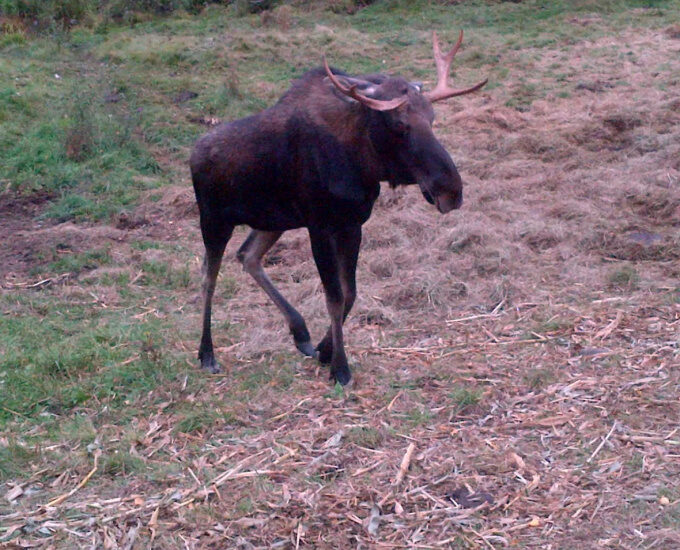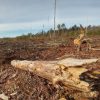
KJIPUKTUK (Halifax) – Lands and Forestry’s systemic failure to satisfy its legal obligations under the Endangered Species Act has been detrimental to the mainland moose population. Now, the species is teetering on the brink of local extinction.
It is worth noting that the mainland moose is a different subspecies from the moose in Cape Breton, which was actually introduced from Alberta. The mainland moose was identified as provincially endangered back in 2003, when there were approximately 1,000 remaining. But a 2019 study deduced that there were likely fewer than 100 mainland moose in Nova Scotia.
Worldwide, the sixth mass extinction is ongoing, with current extinction rates estimated to be 100 to 1,000 times higher than natural background rates. The World Wildlife Fund states, “Wildlife populations in Canada are in serious and significant decline. Even more surprising, the numbers for at-risk species, those protected by law, are just as bad – if not worse.”
We can no longer afford to view the well being of the natural world as disparate from our own. Our entire planet depends on biodiversity, yet the continued mismanagement of our natural resources exacerbates the biodiversity crisis. Nova Scotians don’t want our mainland moose to be the next casualty of the biodiversity crisis – or more precisely – a casualty of the Department of Lands and Forestry.
Nova Scotia’s Endangered Species Act prohibits “destroying, disturbing or interfering with a specific dwelling place or area occupied, or habitually occupied, by one or more individuals or populations of the species.” And yet, Richard Amero came forward with concerns about commercial forestry on moose habitat. Amero provided photos of moose tracks and a moose and calf in the connective forest between the Tobeatic and Silver River Wilderness Areas. Lands and Forestry has since made the ludicrous statement that department staff “are aware of the presence of mainland moose in this area but the cutting sites were selected with the moose’s protection in mind.”
Roads built for forestry operations fragment mainland moose habitat and further endanger the moose by exposing them to poachers and to white-tailed deer, which can carry brain worm (moose sickness). Lands and Forestry’s own website confirms that mainland moose habitats “appear to be the most isolated areas with poor access.” Yet Lands and Forestry is disrupting our moose by allowing more logging roads in remote moose habitat.
Last year, Nova Scotians were so troubled by Lands and Forestry’s dereliction of duty under the Endangered Species Act that they took the department to court. This past May, Justice Brothers of the Supreme Court of Nova Scotia found “a chronic and systemic failure” to implement action required under the Act.
Our mainland moose was one of the representative species in that court case. After being instructed to take positive action, why is the Department of Lands and Forestry seemingly contravening its own laws when it comes to habitat fragmentation and our mainland moose?
While the government acts like it’s business as usual, concerned citizens continue to speak out. One such individual is respected wildlife biologist Bob Bancroft, who was an applicant in the Endangered Species Case. Upon learning of the imminent clear-cutting, members of Extinction Rebellion Nova Scotia quickly set up an occupation on Crown Land in hopes of protecting this endangered species. Multiple groups, such as The Healthy Forest Coalition and Stop Spraying and Clear-Cutting Nova Scotia, are calling for the department to protect this relatively unfragmented habitat from industrial forestry activity.
See also: News brief: Mainland moose habitat in Digby County occupied to protect it from clearcutting
Nova Scotia’s moose need healthy, contiguous, and biodiverse forests to thrive, not more clear-cuts. Clear-cut terrain is already over-represented in our province, which means that moose won’t have adequate shelter from sun in summer or wind and snow in winter.
Once again, Lands and Forestry’s own website admits that the loss of mature forests can be detrimental to moose, which need “various age forest communities to provide food, shelter, security and connectivity of these various habitat components.” Unsustainable forestry practices are unacceptable in light of the biodiversity and climate crises. I have to wonder why our allegedly Liberal government is not only permitting – but encouraging – this fragmentation of habitat.
It’s time for Lands and Forestry to listen to the orders of Justice Brothers. It’s time for them to listen to public feedback. It’s for time for them to listen to science. If you agree, please email the Minister of Lands and Forestry (mindnr@novascotia.ca).
Citizens should not have to sue their government or occupy clear-cutting sites. But Nova Scotians will continue to fight for what is right for our environment and our province.
As Justice Brothers quoted in her ruling, “UNLESS someone like you cares a whole awful lot, nothing is going to get better. It’s not.”
Lindsay Lee is an ordinary citizen who has become increasingly concerned by Nova Scotia’s mismanagement of public resources. She’s passionate about biodiversity, coastal protection, and utilizing natural climate solutions to mitigate the climate crisis.
With a special thanks to our generous donors who make publication of the Nova Scotia Advocate possible.
Subscribe to the Nova Scotia Advocate weekly digest and never miss an article again. It’s free!



